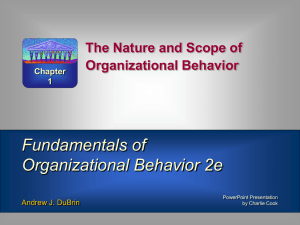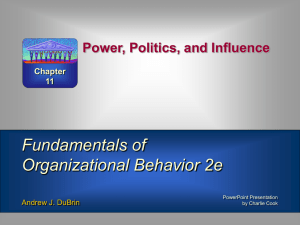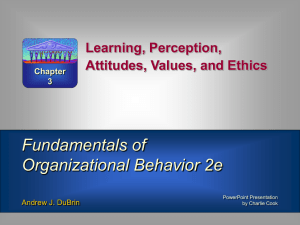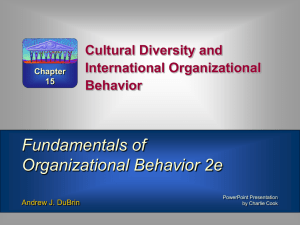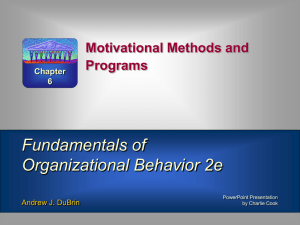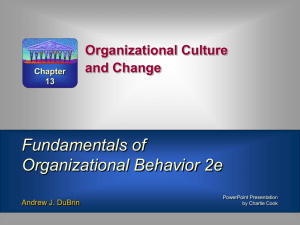Fundamentals of Organizational Behavior
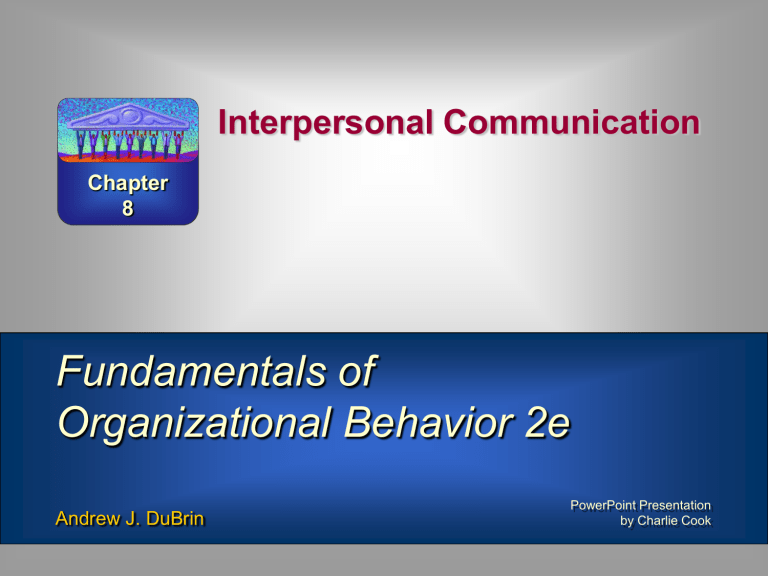
Chapter
8
Interpersonal Communication
Fundamentals of
Organizational Behavior 2e
Andrew J. DuBrin
PowerPoint Presentation by Charlie Cook
Learning Objectives
1. Describe the communication process.
2. Describe the impact of information technology on interpersonal communication in organizations.
3. Explain how nonverbal communication can be used to enhance communication.
4. Present details about the various channels of communication in organizations.
5. Summarize barriers to effective communication and how to overcome them.
6. Explain how to overcome cross-gender and crosscultural communication problems.
7. Recognize the basics for becoming a more poweroriented communicator.
8 –2
A. J. DuBrin, Fundamentals of Organizational Behavior, Second Edition. Copyright © 2002 by South-Western.
The Communication Process
Components of Communication
1. Source (the sender)—person attempting to send a message to another person. Authority and experience of sender can call attention to message.
2. Message—a purpose or idea to be conveyed. Clarity, complexity, length, and organization affect reception of message.
3. Channel (medium)—how and through what media the message is conveyed to the receiver.
4. Receiver—the party to whom the message is sent must get and understand properly the message for communication to take place.
A. J. DuBrin, Fundamentals of Organizational Behavior, Second Edition. Copyright © 2002 by South-Western.
8 –3
The Communication Process
Components of Communication (cont’d)
5. Feedback—reactions of the receiver that indicate the message was received and properly understood.
6. Environment—factors such as organizational culture affect how messages are transmitted and understood.
7. Noise—physical and human relations distractions in the environment can disrupt the communication process.
A. J. DuBrin, Fundamentals of Organizational Behavior, Second Edition. Copyright © 2002 by South-Western.
8 –4
Source
(sender)
The Communication Process
Environment
Noise Sources
Channel
Message
Feedback
Receiver
Noise Sources
EXHIBIT
8-1
Environment
A. J. DuBrin, Fundamentals of Organizational Behavior, Second Edition. Copyright © 2002 by South-Western.
8 –5
Communication and Information Technology
Two major impacts on interpersonal communication
Written messages have replaced telephone and personal conversations.
The volume of messages each manager receives has increased.
E-mail Characteristics
Is unaffected by distance and time.
Enhances industrial democracy by linking workers and leaders.
Encourages indiscriminate sending of trivial information.
8 –6
A. J. DuBrin, Fundamentals of Organizational Behavior, Second Edition. Copyright © 2002 by South-Western.
Communication and Information Technology
The Alternative Workplace
A combination of nontraditional work practices, settings, and locations that supplements the traditional office.
Telecommuting
An arrangement in which employees use computers to perform their regular work responsibilities at home or in a satellite office.
– Has a strong reliance on E-mail.
– Lacks the social interactions of work.
8 –7
A. J. DuBrin, Fundamentals of Organizational Behavior, Second Edition. Copyright © 2002 by South-Western.
Communication and Information Technology
Presentation Technology
The capability to create and effectively use multimedia presentation tools is an essential managerial skill.
Tips for a Professional Presentation
Know how to operate presentation equipment.
Maintain eye contact with the audience and talk to the audience, not to the screen.
Reveal points only as needed.
Keep the slide in view until the audience gets the point.
Use special slide effects sparingly.
8 –8
A. J. DuBrin, Fundamentals of Organizational Behavior, Second Edition. Copyright © 2002 by South-Western.
Communication and Information Technology
Voice Recognition Systems
Are electronic devices capable of recognizing verbal commands and carrying them out by:
acting as virtual secretaries in office messaging systems.
supplementing or replacing keyboarding commands.
Voice systems have difficulty recognizing individual speech patterns, context, and words with multiple meanings.
8 –9
A. J. DuBrin, Fundamentals of Organizational Behavior, Second Edition. Copyright © 2002 by South-Western.
Communication and Information Technology
Nonverbal Communication
The transmission of messages by means other than words, usually as a supplement to written, spoken, or signed communications.
General purpose is to express the feeling behind the message.
A. J. DuBrin, Fundamentals of Organizational Behavior, Second Edition. Copyright © 2002 by South-Western.
8 –10
Nonverbal Communication Behaviors
1. Environment
2. Body placement
3. Postures
4. Hand gestures
5. Facial expressions
6. Voice tone
7. Clothing, dress, appearance
8. Mirroring
A. J. DuBrin, Fundamentals of Organizational Behavior, Second Edition. Copyright © 2002 by South-Western.
8 –11
Organizational Channels of Communication
Formal Communication Channels
Are officially defined pathways for sending information inside and outside the organization.
Organization charts illustrate the channels to be followed.
Network organization
Has spherical structure that can rotate self-managing teams and other resources around a common knowledge base.
Has communication channels that do not follow the formal patterns of hierarchical organizations.
May enter into temporary strategic alliances with other firms to capitalize on combined talents.
8 –12
A. J. DuBrin, Fundamentals of Organizational Behavior, Second Edition. Copyright © 2002 by South-Western.
Communication Pathways in a Hierarchical
Organization and a Spherical Organization
Bureaucracy Network Organization
EXHIBIT
8-2
A. J. DuBrin, Fundamentals of Organizational Behavior, Second Edition. Copyright © 2002 by South-Western.
8 –13
Organizational Channels of Communication
Informal Communication Channels
Unofficial network that supplements the formal channels.
Grapevine
Is the major informal channel in organizations.
Can distort information in its tangled pathways.
Used to spread negative rumors and gossip.
Used to disseminate information along informal lines.
Combating rumors in organizations:
Be wary of vague communications.
Promote healthy, accurate communications.
Avoid concealing bad news.
Correct erroneous communications promptly.
8 –14
A. J. DuBrin, Fundamentals of Organizational Behavior, Second Edition. Copyright © 2002 by South-Western.
Organizational Channels of Communication
Communication Directions
Downward communication:
Flow of messages from a higher to a lower level in the organization.
Danger lies in lack of response from lower level.
Upward communication:
Transmission of messages from lower level to higher levels in an organization.
Improving upward communications:
Management by walking around
Chance encounters
Talking regularly with employees (open-door policy)
8 –15
A. J. DuBrin, Fundamentals of Organizational Behavior, Second Edition. Copyright © 2002 by South-Western.
Organizational Channels of Communication
Communication Directions
Horizontal communications—messages sent to others on the same level in the organization.
Diagonal communications—transmission of messages to other departments at higher and lower levels in the organization.
Spherical communications— communication among members from different teams in the network organization.
8 –16
A. J. DuBrin, Fundamentals of Organizational Behavior, Second Edition. Copyright © 2002 by South-Western.
Organizational Channels of Communication
B a r r r r i i e r r s t t o I I n t t e r r p e r r s o n a l l C o m m u n i i c a t t i i o n
1. S e m a n t t i i c s T h e t t e r m f f o r t t h e v a r y i i n g m e a n i i n g s t t h a t t p e o p l l e a t t t t a c h t t o w o r d s .
.
2 .
.
F i i l l t t e r i i n g o f f n e g a t t i i v e i i n f f o r m a t t i i o n
I I n v o l l v e s c o l l o r i i n g o r a l l t t e r i i n g i i n f f o r m a t t i i o n t t o m a k e t t h e m e s s a g e m o r e a c c e p t t a b l l e t t o t t h e r e c e i i v e r .
.
3
4
5
6
.
.
.
.
.
.
.
.
C s
M
D r
V e i i r e i i a f f f f e n x l l f f e d u d e e r r e i i e d e b e j j r n i i s n l l c u i i i t t t g e d y f f n g r o a a m l l f f s m e t t h e n t t e s s o f f
M e s s a g e v a l l u e a n d i i m p o r t t a n c e a r e b a s e d o n t t h e t r u s t w o r t t h i i n e s s o f t t h e s e n d e r .
Sending different messages about the same topic creates confusion.
People perceive words and concepts differently based on their personal perspective and past experience.
Making a value judgment prior to receiving the message interferes with the communication of the message meaning.
7 .
.
C o o v m e r l l m o u a n d i i c a t t i i o n Occurs when people are so overloaded with information that they cannot respond effectively to messages.
A. J. DuBrin, Fundamentals of Organizational Behavior, Second Edition. Copyright © 2002 by South-Western.
8 –17
Barriers to Communicating and
Means for Overcoming Them
B a r r r i i e r s
S e m a n t t i i c s
F i i l l t t e r r i i n g o f f n e g a t t i i v e i i n f f o r r m a t t i i o n
C r r e d i i b i i l l i i t t y o f f t h e s e n d e r
M i i x e d s i i g n a l l s
D i i f f f f e r r e n t t f f r a m e s o f f r r e f f e r r e n c e
V a l l u e j j u d g m e n t t s
C o m m u n i i c a t t i i o n o v e r r l l o a d
O v e r c o m i i n g B a r r r i i e r s
Clarify ideas before sending.
Motivate the receiver.
Discuss differences in paradigms.
Foster informal communications.
Communicate feelings behind the facts.
Be aware of nonverbal beha vior.
Obtain feedback.
Adapt to the other person’s communication style.
EXHIBIT
8-3
A. J. DuBrin, Fundamentals of Organizational Behavior, Second Edition. Copyright © 2002 by South-Western.
8 –18
Organizational Channels of Communication
Improving the Sending of Messages
1. Clarify ideas before communicating.
2. Monitor the receiver.
3. Discuss differences in paradigms.
4. Foster informal communications.
5. Communicate feelings behind the facts.
6. Be aware of nonverbal behavior.
7. Obtain feedback.
8.
Adapt to the other person’s communication style.
8 –19
A. J. DuBrin, Fundamentals of Organizational Behavior, Second Edition. Copyright © 2002 by South-Western.
E l l e v e n K e y s t o
E f f f f e c t t i i v e L i s t t e n i i n g T h e B a d L i i s t t e n e r r T h e G o o d L i i s t e n e r
1 .
.
F i i n d a n a r r e a o f f i i n t t e r e s t t
2 .
.
J u d g e c o n t t e n t t , , n o t t d e l l i i v e r r y
3 .
.
H o l l d y o u r f i r r e
4 .
.
L i i s t e n f f o r i i d e a s
5 .
.
B e f l l e x i i b l l e
6 .
.
W o r r k a t t l l i i s t t e n i i n g
7 .
.
R e s i i s t t d i i s t t r a c t t i i o n s
T u n e s o u t t d r r y s u b j j e c t t s
T u n e s o u t t i i f f d e l l i i v e r r y i i s p o o r r
T e n d s t t o e n t e r i i n t t o a r g u m e n t t
L i i s t e n s f o r r f f a c t t s
T a k e s i i n t t e n s i i v e n o t e s u s i n g o n l y o n e s y s t t e m
S h o w n n o e n e r g y o u t t p u t t , , f f a k e s a t t t t e n t t i o n
I I s d i i s t t r a c t t e d e a s i i l l y i i
S n e i i e t t k f f s o r o p m p e o
?
r r
” t t u n i i t t i i e s ; ; a s k s “ W h a t t ’ ’ s
J u d g e s c o n t t e n t t , , s k i i p s o v e r r d e l l i i v e r y e r r r r o r s
D o e s n ’ ’ t t j j u d g e u n t i l l c o m p r r e h e n s i i o n i i s c o m p l l e t t e
L i i s t e n s f o r r c e n t r r a l l t h e m e s
T a k e s f f e w e r n o t e s ; ; u s e s f o u r r o r r f f i i v e d i i f f f f e r r e n t t s y s t t e m s , , d e p e n d i i n g o n t t h e s p e a k e r
W o r r k s h a r r d , , e x h i i b i i t t s a c t t i i v e b o d y s t t a t e
F i i g h t t s o r a v o i i d s d i i s t t r r a c t t i i o n s , , t t o l l e r r a t t e s b a d h a b i i t t s , , k n o w s h o w t t o c o n c e n t r r a t e
U s e s h e a v i i e r r m a t t e r i i a l l a s a n e x e r c i i s e f f o r r t t h e m i i n d
8 .
.
E x e r c i i s e y o u r r m i i n d R e s i i s t t s d i i f f f f i i c u l l t t e x p o s i i t t o r r y m a t t e r i i a l l ; ; s e e k s l l i i g h t t , , r r e c r r e a t t i i o n a l l m a t t e r i i a l l
R e a c t t s t t o e m o t t i i o n a l l w o r r d s 9 .
.
K e e p y o u r r m i n d o p e n
1 0 .
.
C a p i i t t a l l i i z e o n t t h e f f a c t t t t h a t t t t h o u g h t t i i s f f a s t t e r r t t h a n s p e e c h
1 1 .
.
R e s t t a t t e w h a t t y o u h e a r r
T e n d s t t o d a y d r e a m w i i t t h s l l o w s p e a k e r r s
R e a c t t s t t o w h a t t h e o r r s h e h e a r s
I n t t e r r p r e t s c o l o r r w o r r d s ; d o e s n o t t g e t t h u n g u p o n t t h e m
C h a l l l l e n g e s , , a n t t i i c i i p a t t e s , , m e n t t a l l l l y s u m m a r i i z e s , , w e i i g h s t t h e e v i i d e n c e , , l i s t t e n s b e t t w e e n t t h e l i i n e s t t o t o n e o f f v o i i c e
C o w t t l l a h h r r e a i i t t r f f i i
I I ’ ’ e p s e m r r w s s h o a y a n i i t t s n h a g .
.
e y r o r r s h e h e a y s , , ” Y e s , , t h i i s i s
” a r r s u n t t i i l l
EXHIBIT
8-4
Source: John W. Richter, “Listening: An Art Essential to Success,”
(September 1980): p. 26; Lyman K. Steil, “How Well Do You Listen?,”
Executive Female , Special Issue No. 2 (1986): p. 37.
A. J. DuBrin, Fundamentals of Organizational Behavior, Second Edition. Copyright © 2002 by South-Western.
8 –20
Organizational Channels of Communication
Key Gender Differences in Communication Styles
Male Preferences Female Preferences
To talk to preserve independence and status by displaying knowledge and skill.
To use communication for rapport building.
To work out problems by themselves.
To talk out solutions with another person; want empathy and understanding.
Are more likely to be critical of the work of a coworker.
Tend to be more directive in their conversations.
Are more likely to compliment the work of a coworker
Emphasize politeness toward others.
Tend to be intimidating when facing differences.
Tend to be more conciliatory when facing differences.
More interested in calling attention to their accomplishments or hogging recognition.
Tend to dominate discussions.
Less interested in calling attention to their accomplishments or hogging recognition.
Tend not to seek to dominate discussions.
Are more likely to minimize doubts. Tend to downplay their certainty.
A. J. DuBrin, Fundamentals of Organizational Behavior, Second Edition. Copyright © 2002 by South-Western.
8 –21
Overcoming Cross-Cultural
Communication Barriers
1. Be sensitive to the fact that cross-cultural barriers exist.
2. Show respect for all workers.
3. Use straight-forward language and speak slowly and clearly.
4. Be alert to cultural differences in customs and behaviors.
5. Be sensitive to differences in nonverbal communication.
6. Do not be diverted by style, accent, grammar, or personal appearance.
A. J. DuBrin, Fundamentals of Organizational Behavior, Second Edition. Copyright © 2002 by South-Western.
8 –22
·
Members of Asia and some other
Middle-Eastern cultures consider direct eye contact rude.
·
Japanese people rarely use the word
“no”. When they say “yes” (“hai”), it only acknowledges that they have heard what was said.
· When Japanese people say “We’ll consider it,” they probably mean “no.”
·
Korean people are hesitant to say
“no” even when they have rejected a proposal. Koreans feel it is important for visitors to leave with food feelings.
·
British people understate their feelings. If a British person says,
“Your report does raise a few questions,” the real meaning is probably “Your report is atrocious.”
·
People from Latin America are very conscious of rank, and they expect the manager to be the voice of authority. Consequently, Latin
Americans may be hesitant to make suggestions to a superior.
·
Americans are eager to get down to business quickly and will therefore spend less time than people from other cultures building a relationship.
·
Americans value time much more that do people from other cultures. They are therefore more likely than people form other cultures to appear perturbed when a person shows up late for a meeting.
·
French-speaking people tend to use polite forms of greeting, particularly in business settings, while Americans are less formal. When greeting a business contact in a French-speaking country, it is therefore important to include the prefix sir, monsieur, madame, ms., mademoiselle, or miss.
Skill Developm ent: The above informati on will lead to cross-cultural development if practiced in the right setting. During the next 30 days, look for an opportunit y to relate to a person from a given culture in a way described above. Observe the reaction of the other person to provide feedback on your cross-cultural effecti veness.
EXHIBIT
8-5
A. J. DuBrin, Fundamentals of Organizational Behavior, Second Edition. Copyright © 2002 by South-Western.
8 –23
The Power-Oriented Linguistic Style
Components of a linguistic style that give power and authority to the message sender:
Choose words that show conviction such as
“I’m convinced” or “I’m confident.”
Use the pronoun “
I” to receive more credit for your ideas.
Emphasize direct rather than indirect talk.
Frame your comments in a way that increases your listener’s receptivity.
Speak at length, set the agenda for a conversation, make jokes and laugh.
A. J. DuBrin, Fundamentals of Organizational Behavior, Second Edition. Copyright © 2002 by South-Western.
8 –24
The Power-Oriented Linguistic Style
(cont’d)
Components of a linguistic style that give power and authority to the message sender:
Minimize the number of questions you ask that may imply you lack information on the topic.
Apologize infrequently and particularly minimize saying, “I’m sorry.”
Take deep breaths to project a firm voice with power and conviction.
Occupy as much space as possible when speaking before a group.
8 –25
A. J. DuBrin, Fundamentals of Organizational Behavior, Second Edition. Copyright © 2002 by South-Western.
